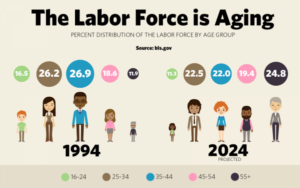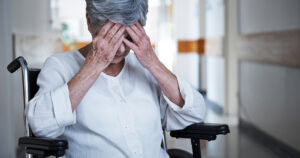According to the Australian Institute for Health and Welfare, in 2020, 16% (4.2 million) of the Australian population were aged 65 and over; this proportion is projected to grow steadily over the coming decades.

Partly, growth in the proportion of older Australians is due to increasing life expectancy: in 2022, a 65-year-old man could expect to live another 22 years and a 65-year-old woman another 24 years. On average, Australian men aged 65 in 2022 could expect to live to around 87, and women to 89. However, the figure for Indigenous Australians are much different, as are most other facets of growing older. The latest life expectancy figures 2022 showed that Indigenous women lived on average 75.6 years and men 71.6 One of the major needs for this group is to raise the life expectancy to match the the Australian average, however the 2023 Closing the Gap report has shown we are not on target to do this.
The fact that overall we are all living longer and with generally good health into out later years is a remarkable success story. But there are some significant problems with the way we are responding to this change in our communities. Most of the current research around the experience of ageing in Australian society highlights a handful of major social justice issues: work, elder abuse, and poverty, especially in relation to housing costs. However, underlying these specific challenges is the real problem of social and cultural attitudes that do not see the dignity of older people, that believes they have nothing to offer and are simply social burdens. Any systemic changes will require a change in these community attitudes.
Old age is not a shipwreck but a vocation.
-Archbishop Vincenzo Paglia
Work
There are two related issues in this category. First, is the pernicious problem of ageism, this has meant that over a quarter of people aged 50 or over have experienced discrimination in the workplace. A 2022 report from Australian Human Rights Commission Report noted that this discrimination took different forms and included being denied employment, promotion or training and being subject to derogatory treatment. This has led many to give up the job search, and adversely affects those already vulnerable like Indigenous people. Aboriginal and Torres Strait Islanders aged 15-64 already face enormously lower rates of employment at 56% compared to 78 % for non-Indigenous (in 2021-period), so the difficulties non- Indigenous older people face in the workforce are even more complex and compounded for First Australians.

Being denied work or experiencing discrimination in the workplace because of age, aside from being personally harmful in many ways, has significant impact on people’s financial lives at a time when many can least afford to be dipping into savings or otherwise struggling to make ends meet. Older people, no less than anyone else, deserve to have their skills, knowledge, experience and most importantly their dignity recognised by allowing fair participation in the workforce.
The second problem associated with work is a growing push for people to work much later into their older years with increasing retirement ages. While people who want to and can participate in the paid workforce should be able to do so free from discrimination, working longer than one is able to should not be forced upon people. While longer working years may suit some people, it will not be appropriate for all, such as those who have laboured in physically demanding jobs or those have caring responsibilities at home, for example. In such cases we cannot allow a narrative of older people as ‘burdensome’ and ‘unproductive’ to dominate the way we think about these people. There are economic challenges, to be sure but along with research that counters this view, it is such a limited view of what keeps our country valuable and working.

Older people, like every person, cannot be reduced to economic units and their contribution and worth to our communities is not to be measured in what they earn or own. We all suffer under the prevailing attitude of a ‘throwaway’ culture that devalues contributions like volunteering and family and caring duties – activities which if monetised are hugely beneficial to the country’s economy. Older people have a lot to contribute to our society just by their very presence.
Be subject to one another out of reverence for Christ
-Eph. 5:21
Elder Abuse

Homelessness
On Census night in 2021 22,494 people over age of 55 and older were experiencing homelessness. Though they are underrepresented in the homelessness, many scholars and experts agree that this group, particularly women, are increasingly at risk of homelessness. This is for a range of reasons, but the major one is housing affordability.

From roughly the middle of last century outright home ownership by the age of retirement has been the bedrock of our retirement system. Yet over the last 20 or so years as housing affordability has plummeted so has the ability of people to move out of the rental market into the ownership market. Between 1995-1996 the percentage of 44-55 years old renting rose from 18.4 to 25% – a number that is expected only to increase. And even for those who do manage to purchase a home fewer are reaching retirement with a completely serviced mortgage. These factors, combined with a reduction in social housing, means that people will be relying on superannuation, the Age Pension and other other Government assistance to meet shelter costs which puts an enormous amount of economic pressure on people whose incomes are typically retracting or cease altogether across these years, as well as pressure on Government finances to meet these needs.
As in all homelessness, certain people are more vulnerable than others. Alongside groups who are at higher risk of homelessness at any age because of risk factors like domestic violence, being Indigenous and having a mental illness, older single women are an increasingly large group experiencing or at risk of homelessness. Housing affordability is the central piece of this picture but it is compounded by the uneven paid working lives many women experience which results in less superannuation, and is made more severe by the fact that women tend to be paid less than men over the working lives. For these women, divorce or death of a spouse or a loss of a job are catastrophic events from which they do not have the financial capital or time in the workforce to recover. More specialist service are needed to respond to the needs of this group, but structural injustices around the way we value work typically done by women is also desperately needed. Systemic changes around our retirement system, both in terms of the unfair gendered outcomes of our superannuation system and the reliance on home ownership as the cornerstone of safe retirement need to be addressed.
A note on the euthanasia debate
The same troubling trend in the culture to value people not by their dignity but by their economic productivity and ‘usefulness’ that leads to the kind of discrimination, poverty and abuse outlined above is one part of the reason the Church steadfastly opposes euthanasia or ‘assisted dying’. In such a culture there is a high likelihood of abuse as well as older people suffering acute social and familial pressure to ‘choose’ euthanasia because of narratives about being ‘burdensome’ . For this, and for the many other reasons the Church protests euthanasia, we must work hard to create a more just society with more loving and truthful narratives about the true meaning of our dignity and the best ways to respect and cherish it.
 Some links to learn more about the Catholic position on euthanasia and surrounding debates:
Some links to learn more about the Catholic position on euthanasia and surrounding debates:
- Australian Catholic Bishops Commission for Pastoral Life – ‘Alternatives to Euthanasia’
- Video Footage of Debate between Archbishop Fisher and Professor Peter Singer on Voluntary Euthanasia.
More Information and Getting Involved
- To learn more about Church teaching and thought click here.
- For more information and to get involved click here.
You shall rise up before the grey-headed and honour the aged, and you shall revere your God.
Lev. 19:32
